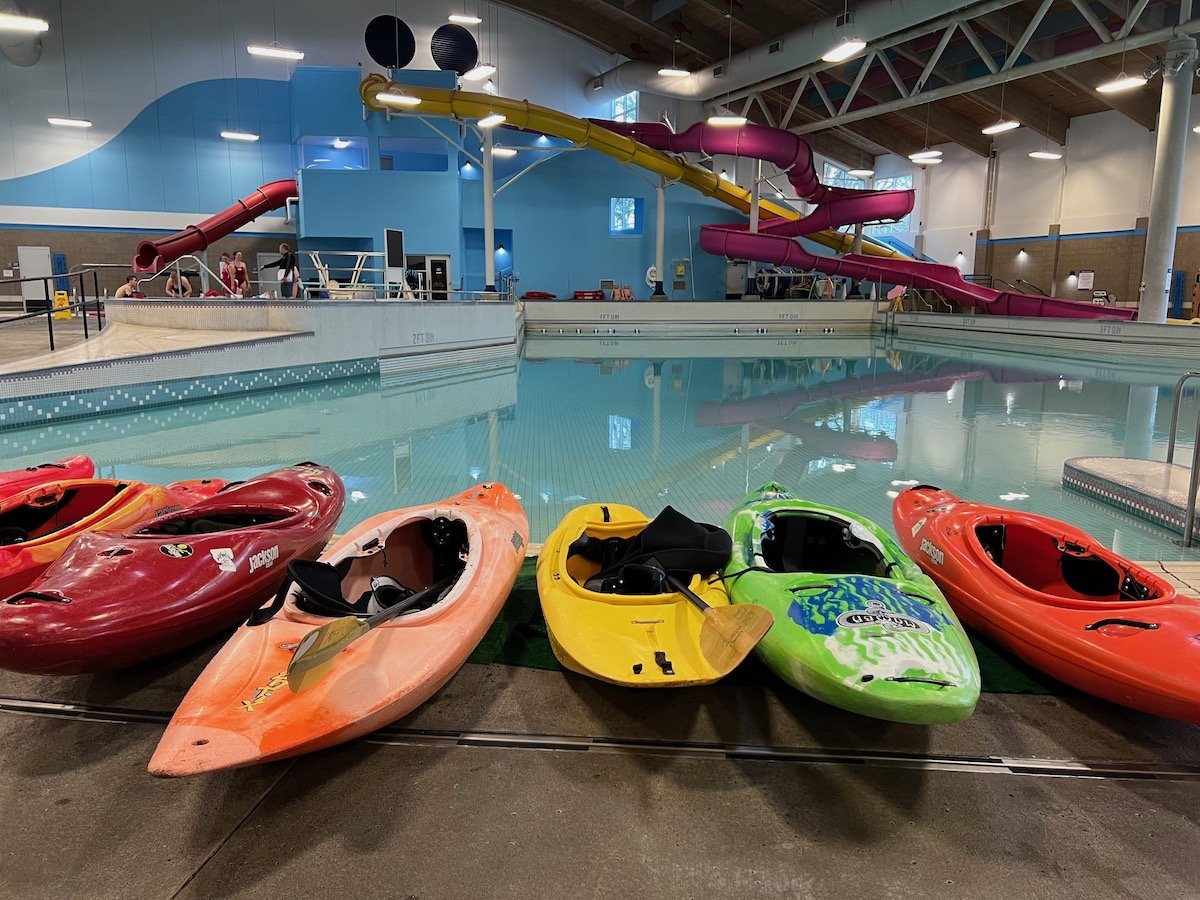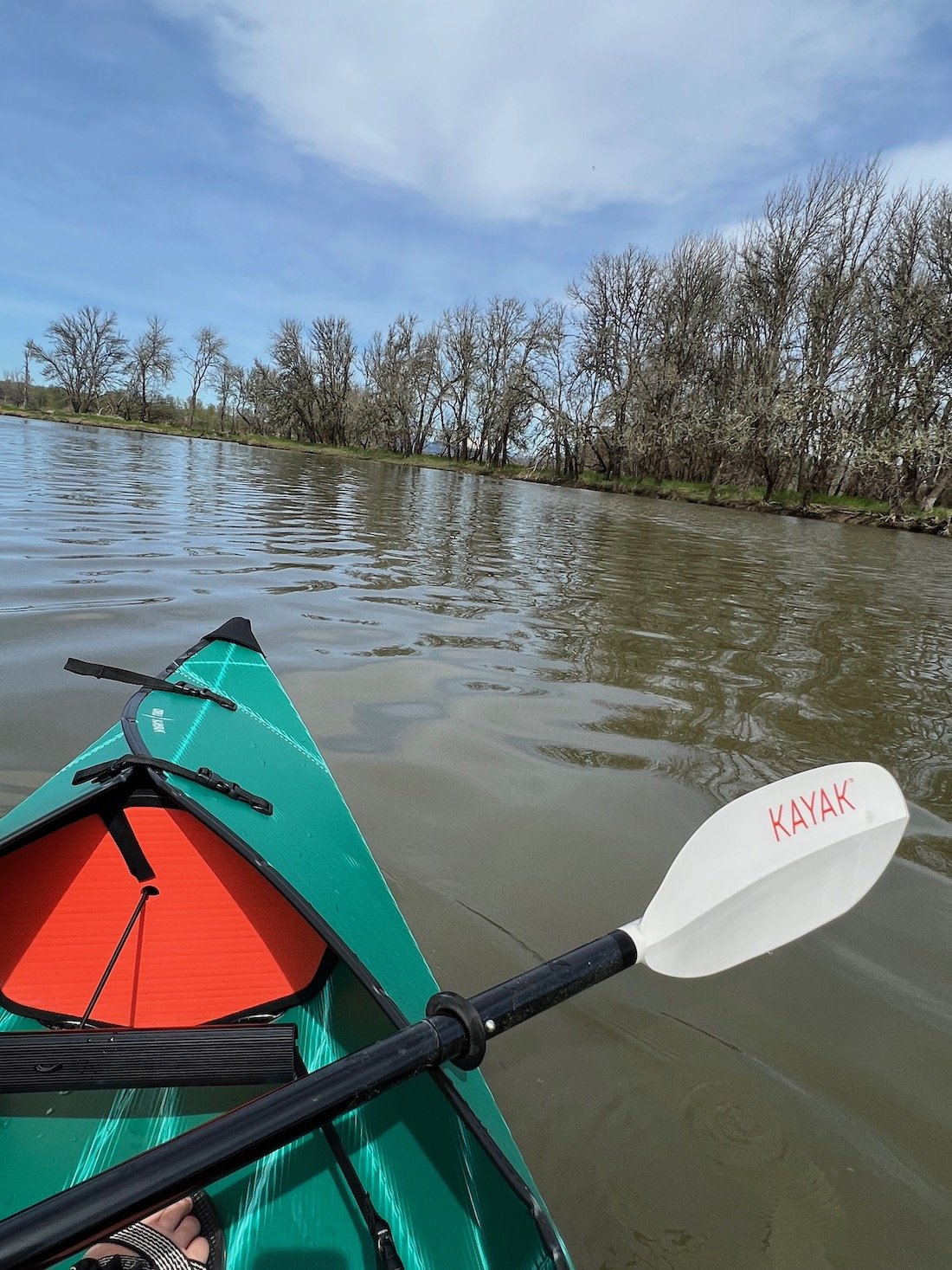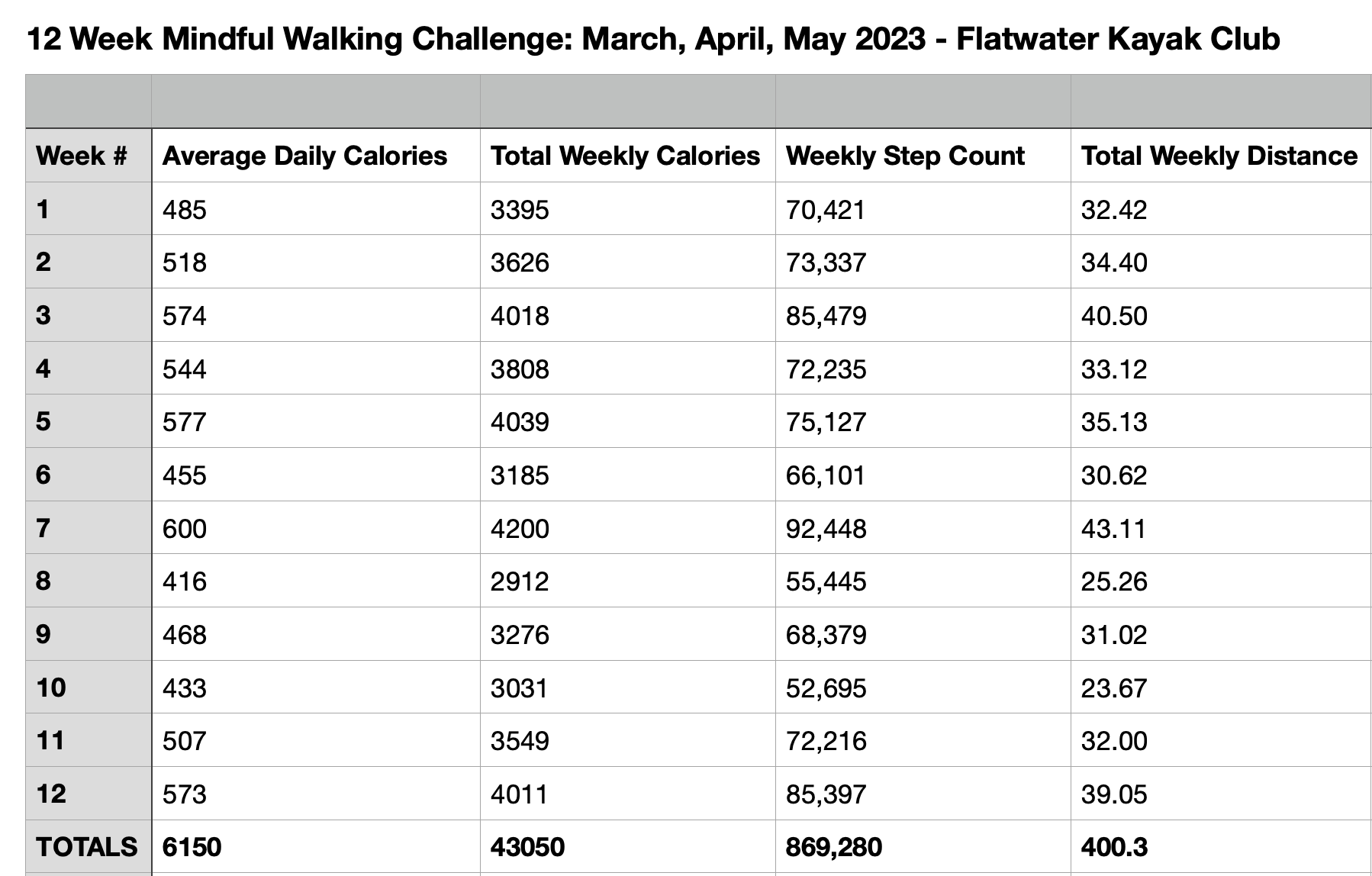I walked over 400 Miles in 12 weeks– here's how it prepared me for kayaking
I spent March, April, and May of 2023 on a 12-week mindful walking journey – and ended up walking over 400 miles.
The distance between Boston and Baltimore.
No treadmills, no running. Just walking outdoors, short and long distances, during all times of day and in all Pacific Northwest weather conditions.
Join me on a story from trails to water as I share how daily walking enhanced my kayaking skills, fitness, and love for the great outdoors…
Over my three-month walking challenge, I walked in all sorts of weather at all times of day, across two states. I took a photo of my weekly walking summary every Sunday night. In the documented week pictured in this Apple Watch photo, I had crossed the 40-mile mark for the first time over during a week’s worth of mindful walking. [Portland, Oregon, taken by Flatwater Kayak Club].
Table of contents jump links:
The beginning of daily mindful walking (setting my goals & data-collecting method),
My 3-month walking journey recap (positives & challenges),
Why I began this personal walking challenge
For the ten years I lived in New York City, I can’t think of a time when I regularly tracked my daily steps. With all of my work, family, and personal activities, it wasn’t hard to rack up the (so-called) recommended daily 10,000 steps… or more. It was just part of my normal life.
But after moving to Portland, Oregon during the pandemic – and despite having a pretty active lifestyle – my regular weekly routine of fully-remote work and chauffeuring my kids around town took a real hit to my daily movement last year.
I noticed during the holidays of 2022 that my daily step average had dropped to…. an extremely, extremely low number. Honestly it’s embarrassing to even post publicly. Some things are only for phone calls with your sister.
And the numbers started keeping me up at night.
I’m a mostly healthy, able-bodied human, and a parent to two small children. I want to take care of myself and live as long and active lifestyle as I can. And I want to have a healthy heart.
With prime kayaking season right around the corner, the motivation to have a stronger body and improved cardio health was the boost of motivation that I needed.
Going to bed one night, I decided I needed to make an immediate lifestyle change.
This website may contain affiliate links meaning if you purchase through my link, I’ll receive a small commission at no cost to you.
The beginning of daily mindful walking
This personal challenge started as most things do, and that’s a step at a time.
Back in that first week of March, 2023, I didn’t know that I’d end up dutifully tracking my steps for three months straight, or what my final mileage goal would be at the end of the challenge.
But I committed to this: Daily mindful walking to improve my cardio health.
I didn’t weigh or measure my body, or get blood work or an EKG done. I felt physically ready and made the commitment to start – even if slowly, in the beginning.
During the first couple of days and over the early weeks, I just focused on small wins. Committing to shorter walks, every single day. Nothing overwhelming, or too lofty a goal to feel unattainable at that time.
Some of the small goals I set for myself in the beginning included:
Ten minutes here, 15 minutes there. Minutes + steps = motivating gains.
Getting some fresh air during my lunch break.
Taking walking meetings when appropriate and possible.
Use coffee walks as an excuse to get moving.
Give my dog a few extra loops around the block.
Park further away from entrances when getting groceries.
Walk as many errands as I could from my house.
Ask friends and my partner to meet up for catch-up walks instead of cocktails.
Randomizing my walking speed baed on how I was feeling that day.
Trying to be present in the moment and enjoy the journey, and not make it feel like just another a chore in my day.
I documented my walking statistics by:
Wearing my Apple iWatch every day to track my steps, miles, and calories.
Taking a photograph of my “week summary” every Sunday night for 12 weeks,
Sharing my walking journey on Instagram Stories each week for personal motivation and accountability,
Using a custom spreadsheet to fill in all the weekly walking numbers and calculate the totals.
How I identified my personal walking challenge goals
After a couple of weeks, I began to see some patterns in my data.
And I started to really know in my body – mentally and physically – how challenging it was for me to walk 5,000, 10,000, or even more steps a day. And even more importantly, on which day of the week.
My Monday-Friday weekdays were often filled up with work and family obligations. Making the time to walk longer distances was a bit harder to do. So it became important to carve out longer times to walk on the weekends. I also started to feel motivated by the fact that all the little walks really added up over time. Each step really did count!
Since I wasn’t weighing myself or taking physical measurements for personal motivation, seeing these numbers come together on my spreadsheet and sharing them with my community really became a motivating driver for me to hit an overall, bigger walking goal goal.
I felt how easy or difficult it was for me to hit 20, 30, and then even 40 walking miles per week. I did the math, and started to believe that walking 400 miles would be possible in 3 months, if I kept up with my daily consistent actions and hit the averages that I was already achieving. I knew some weeks would be harder than others (especially with travel).
But I decided that I could do it – walk 400 miles in 12-weeks.
Throughout this personal 12-week walking challenge, I reminded myself that routine consistency was key – and gradually increased the walking intensity and duration would help me meet my specific fitness and heart health goals.
The intersection between walking and kayaking fitness
One of my big motivations for me doing this 3-month walking challenge was knowing that amazing kayaking weather was right around the corner in Oregon.
I wanted to feel strong for my paddling adventures, and capable of taking on longer kayaking routes or more difficult experiences. Having a strong heart and body would help me be as safe a possible in those situations, and enjoy them even more.
If you’re also interested in starting a walking routine to support your kayaking hobby, there’s a lot of ways that walking can enhance your recreational kayaking fitness.
12 ways regular walking and support your kayaking fitness:
Improved cardiovascular fitness: Regular walking can improve your cardiovascular endurance, which is essential for kayaking. Better cardiovascular health means your body is more efficient at transporting oxygen and nutrients to your muscles, which can help you paddle longer and harder (thanks for the heart health research, Mayo Clinic).
Increased core strength: Walking, especially brisk walking or hiking, engages your core muscles. A strong core is essential in kayaking for maintaining balance and stability in the water. It also facilitates efficient paddle strokes.
Enhanced leg strength: Although kayaking is primarily an upper body and core workout, leg strength is also important. You use your legs to maintain your balance and assist in your stroke. Regular walking can help to improve your leg strength, which can translate into better control and stability when kayaking.
Increased flexibility and joint health: Regular walking can also help maintain joint flexibility and health, which is important for the full-body range of motion used in recreational kayaking. This is especially true for your hips and ankles, which can experience unique stresses during a kayaking session.
Mental preparedness: Regular physical activity, like walking, has been shown to reduce anxiety and depression, improve mood, and boost self-esteem. This is a big one – and one that can be often underestimated. Mental well-being is crucial in recreational activities like kayaking, where calm and focus can enhance your experience and performance.
Adapting to weather conditions: Walking in various weather conditions, whether it's sunshine, rain, or wind, can help enhance your mental resilience and adaptability. You learn to appreciate nature in all its forms, prepare for different scenarios, and understand how different conditions affect your physical performance. Similarly, while it's important to choose safe conditions for kayaking, your experience walking in different weather can help you adapt more quickly when weather conditions change unexpectedly while you're on the water. You'll also develop a keen sense for interpreting weather patterns, which is a valuable skill for any outdoor activity. (Always remember to prioritize safety and check weather forecasts before setting out for kayaking – when you’re on a boat on a river, this is obviously a different safety situation than when you’re out walking).
Nature exposure and stress reduction: Both walking and kayaking often take place in natural settings, which have been shown to improve mental health (and who doesn’t love seeing cute and adorable animals in the wild?). Personally, I chose to only walk outside and not on a treadmill during this fitness challenge. Spending time in nature can reduce stress, enhance mood, and improve cognitive function. Moreover, being exposed to natural sunlight can help regulate your circadian rhythm, improving your sleep quality and overall well-being. Familiarity with outdoor conditions, gained through regular walking, can also improve your comfort and performance while kayaking.
Assists with weight management: Combined with healthy eating, regular physical activity like walking can help maintain a healthy weight or even lose weight – whether you’re walking or kayaking.
Improves balance and coordination: The physical act of walking improves balance and coordination, which is an important part of kayaking as well.
Improves brain function: Physical activity increases blood circulation and the oxygen and glucose that reach your brain. Walking is also known to delay cognitive decline and lower the risk of dementia.
Aids digestion: Regular physical activity, like walking and kayaking, can help your digestive system function more efficiently.
Promotes creativity and productivity: Walking can clear the mind, improve mood, and boost creativity. Many people find they generate lots of good ideas while they're walking. I also find this to be true when I’m out flatwater kayaking.
My 12-week walking journey recap
The positives
There were countless positive things that came from this experience for me, including some of the key points mentioned above, but some of the main positive benefits I found during this 12-week walking experiment included:
Improved strength
As the weeks went on, I felt notably stronger, and the longer walks got easier and easier. When walking up and down hills, I didn’t get out of breath as quickly as back in the winter months.
During week 4, when I traveled to California, I was treated to a massage and the masseuse had commented that my legs were really strong, so that was super motivating, even when I didn’t visually see a difference in muscle tone yet.
I also noticed a difference during the three times I went kayaking throughout this walking experience, which I share in three photos and more detailed captions below.
Improved kayaking fitness
During week 5, I took an intro to whitewater kayaking class (a big cardio endurance workout!).
During week 8, I enjoyed my first green edition Oru kayak flatwater paddling trip (a more relaxing paddle).
During week 10, I took a harder, more intermediate kayaking trip to the Willamette Narrows. Having 2+ months of daily cardio fitness under my belt really helped make this a more enjoyable experience.
Then, one week after this challenge ended, I had a 5-mile flatwater paddle for the Big Paddle Ridgefield event in Washington and felt AMAZING. While I didn’t track any active calories burned, I felt strong and loved the experience.
Week 10 of walking: I snapped this photo on one of my first kayaking adventures into my walking journey. This was a challenging flatwater paddle (and whether it was flat water at all is really up for debate). There were boat waves, winds, and a current to contend with on the river before getting to the calmer waters of the Willamette Narrows. Was glad I felt strong on this adventure because it was a hard one.
And on my final day and walk – which, as fate would have it, required a half marathon walk to meet my 400-mile total mileage goal – and I really noticed improved strength and cardio health improvements. I was fatigued, but not overwhelmingly so.
One week after this walking challenge ended, I enjoyed a 5-mile paddle with over 100 other kayakers, canoers, and SUP paddlers for the Big Paddle Event in Washington. I felt very strong and had a wonderful time.
Reduced anxiety and stress
I have a stressful job and an anxious mind, and taking walk meetings when possible, or having a scheduled walk with my dog during my lunch break really made a difference in my stress levels throughout the day.
Spending those extra minutes out in nature and moving my body were a great benefit to me.
As the weeks progressed with my daily walking, as as the walks grew longer and more rigorous, I also felt like my brain became sharper in remembering details and staying on all my various tasks.
Joy in walking my errands
I live in a pretty walkable Portland proper neighborhood, with a lot of shops, cafes, and restaurants within 2 miles of my home. But previous to this experience, although I rarely drive on a daily basis, I often drove to run my weekend errands.
I learned from this that I really enjoyed keeping a reusable bag in my pocket and walking to get groceries, pick up a coffee, connect with friends, or visit the local pet store.
Witnessing nature’s miracles
Walking daily during the months of March, April, and May allowed me to really be a present part of Spring’s awakening in the Pacific Northwest.
I experienced the rains first-hand, felt the first sun bursts along with the plants, and witnessed countless trees and bushes bud and bloom. Spring is spectacular in Oregon!
Celebrating non-scale victories
I really enjoyed not tracking my weight or body measurements throughout this fitness challenge, and really looking at it as an opportunity to celebrate NSV’s.
This wasn’t some “bikini body” challenge, but a deep, mindful approach to improve my cardio health and take better overall care of my body.
The challenges
Some of the hardest things for me during this personal walking challenge included:
Making time
Being a full-time W2 employee, side hustle business owner, and a parent to two elementary-aged kids added to the many big responsibilities on my plate – so sometimes making the time felt like a slog. Walking takes time! Sometimes many, many hours a week. It was the little added walks over time that made a real difference to my bigger numbers, and including my family, dog, and friends in my walking journey to spend time with them outside.
I had a nearly week-long trip to California during this walking adventure, so carving in times to walk during that time required added effort to keep me on target with my fitness goals.
I also had to do some walks in the evening or at night – one time, as late as 11pm, which bummed me out at first since I was feeling lazy, but I learned how lovely and quiet it is to walk at night, and how each time of day outside really had its own special aspect to it.
Unfavorable weather conditions
The rainy Portland weather was harder in the early Spring months. I endured weather conditions as low as 40 degrees in March, and up to the high 80’s in May, and everything from typical rainstorms to unexpected hail to glorious sunshine. (Having good walking gear was important).
But honestly it surprised me how I soon found these colder, rainier walks quite refreshing and looked forward to them, no matter the weather! So this really was a challenge for me in the first month or so of walking.
Being married to my Smart watch
Remembering to charge my Apple Watch every night, racing to put it on first thing in the morning, tracking my daily walk open workouts, and snapping my Sunday night weekly summary flip-flopped from being helpful and motivating, to annoying and restrictive.
I had a few times when my watch battery died and I reworked my schedule so it could be charged for my walks. And one day, I completely forgot my watch for half the day and was really bummed that I was “missing” out on my mileage. Which is silly, because the whole point of this was to take better care of my body, which counts whether an app tracks my steps or not (sadly, it was a vanity hang-up, in the end).
The day after this challenge ended, it was so nice to not wear my watch at all. While I enjoy having the advanced fitness tracking features of a Smart watch for the motivation and documentation, I am glad to not having it tracking my every move going forward.
Staying committed on the days I wasn’t motivated
There were definitely many moments when I would’ve preferred to curl up on the couch and watch Netflix instead of moving my body. Especially a few weeks here and there when I didn’t feel my best (the last month of this challenge, I had endured a cold, chest cough, and eye infection that impaired my vision a bit), or if the weather was crummy outside.
Sometimes I just had to tell myself that I’d walk ten minutes, and see how I felt. And generally just committing to 10 minutes helped me keep going to hit 15, or 20, or even 30 minutes of walking in a stretch. The little walks all really did add up, and then I felt better and stronger on my longer walks that were many more minutes and miles at a time.
Doing this walking challenge alone
Since I made this goal for my own personal heart health and cardio fitness, I wasn’t part of any fitness group, or fundraising effort, or sporting event. It was mostly just me, my body, and my mind out there slogging along, step after step. At times it was lonely. Sometimes I enjoyed the solitude.
I tried to use this time productively by bringing my kids and dog into walking routes when possible, listening to podcasts and audiobooks (hours and hours of podcasts), calling my parents and catching up with them on the phone, enjoying new music, and mindfully leaving my AirPods at home to just listen and enjoy the sounds of nature.
Next time around, I think it’d be fun for community and accountability to take part in a group walking challenge.
My 12-week walking challenge statistics
Interested in my total numbers at the end of this challenge?
Number of weeks: 12
Total steps walked: 869,280
Total calories burned (including kayaking trips): 43,050
Total walking mileage: 400.30 miles
Average daily mileage: 4.76
Average daily step count: 10,349
Average daily calorie burn: 512
I documented each weekly walking summary with a photo and caption on my Instagram Stories (I will post the video reel here after I pull it together). Here is the spreadsheet of each week and grand totals:
The journey ahead – my future goals
Well, as you might have guessed it, with kayaking season kicking off here in the PNW, I plan on shifting my fitness goals to weekly kayak trips. There are so many new kayaking routes I want to explore, and some guided experiences that I’ve bookmarked for travel. I can’t wait to spend much more time on the water!
I’d like to try out rucking (my family raves about it) and get back into weight training. Another thing I hope to do is hike some of the PCT this summer, especially while I have this fitness foundation under my belt.
I also plan on continuing many of the great habits I started during this Spring – walking longer with my dog, spending more time outside no matter the weather, walking my errands, and using my time outside to de-stress from the responsibilities of life.
And what I’m also looking forward to…? I think I’ll enjoy not tracking my every move and keep my Smart watch at home for awhile :)
2024 training season update
I bought a GoRuck carrier and 10 pound plate! I will be incorporating rucking into my wellness routine, and sharing updates here. Learn more about my top 2024 buys to prepare for kayaking season here.
Archive
- September 2024
- August 2024
- July 2024
- June 2024
- May 2024
- April 2024
- March 2024
- February 2024
- January 2024
- December 2023
- November 2023
- October 2023
- September 2023
- August 2023
- July 2023
- June 2023
- May 2023
- April 2023
- February 2023
- January 2023
- December 2022
- October 2022
- September 2022
- August 2022
- July 2022
About Flatwater Kayak Club
Flatwater Kayak Club is a leading woman-owned online platform dedicated to supporting beginner and intermediate kayakers in the Pacific Northwest. Our company founder, a former writer for The National Geographic Channel and a current ACA member, guides our mission with her passion for kayaking, nature, and storytelling





















![Floating home cabin for rent [REVIEW]](https://images.squarespace-cdn.com/content/v1/62c5c6be9225615a8d0231a9/5288183e-d43e-418c-9fa1-095bc59b4e3f/FloatingHome-Rental-Oregon-OruInlet-Kayaking-FlatwaterKayakClub.jpeg)
Paddling across the glacier-clear waters of Eastern Oregon in a clear-bottom kayak under a sky full of stars is an unforgettable adventure.